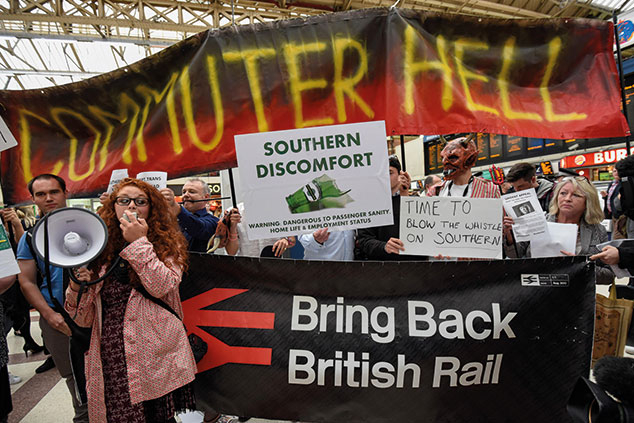
What has happened?
The government has announced a “root and branch” review into the operation of Britain’s rail network. The consultation, to be headed by former British Airways boss Keith Williams, is expected to last a year and has been billed as the biggest review of the system since privatisation in the 1990s under John Major’s government. It is only five years since the Brown Review declared that Britain’s railway franchising model was “not fundamentally flawed”. Yet a catalogue of recent scheduling and business fiascos suggest that there are indeed systemic problems.
How are the railways organised?
Though the rail network is often described as privatised, Britain’s railways are in fact a peculiar marriage between the private and the public. The infrastructure is owned and maintained by state-backed Network Rail, while services are delivered by 25 private franchises that bid for the right to operate specific routes, with the more profitable franchises turning over “premium” payments to the state for the privilege. The railways also continue to receive significant state subsidy, put at £4.2bn for 2016-2017. That is more in real terms than the network received in the decade leading up to privatisation, although that should be set against the fact that the number of passengers has more than doubled since the era of British Rail.
And is the system working well?
Not really. Fares have risen at roughly double the rate of wages since 2010 according to an analysis by the RMT union, but many commuters will not feel that their experience justifies the price hikes. Virgin Trains East Coast went bust in May after the number of passengers failed to meet expectations, forcing the Department for Transport (DfT) to take the London to Edinburgh route back into state ownership. That is the third time since the millennium that franchise agreements on the line have hit the financial buffers. Ongoing strikes at Northern Rail and South Western Railway over the future of train guards don’t suggest a harmonious network either.
What else has gone wrong?
A timetabling fiasco in May this year saw 15,000 trains cancelled or severely delayed as a result of chaos at Northern Rail and Govia Thameslink. An interim review by regulator the Office of Rail and Road (ORR) found that “nobody took charge” as the crisis mounted, with the current structure instead allowing train franchisees and Whitehall to pass the buck back and forth. That makes some wonder whether a return to something resembling the old British Rail set up would improve accountability and lines of authority.
What about nationalisation?
Labour advocates renationalising the railways. Polling suggests that the public is on its side, with about 60% of voters in favour and only one-fifth opposed. Railways are natural monopolies – no one else is going to come along and build a second network to compete – and some argue it doesn’t make sense for private operators to be creaming off profits, especially when the state is simultaneously ploughing billions of pounds in new investment into the network.
And what is the counter-argument?
Defenders of privatisation point out that journeys by rail have boomed since privatisation – with the number of passengers up 117% – and that Britain now boasts one of the best rail-safety records in Europe. State-owned continental rail systems often look impressive to visiting British tourists, but they don’t come cheap. Deutsche Bahn has €20bn in debt, while the future of French national operator SNCF’s €47bn debt load was a significant point of contention during prolonged strike action earlier this year. The deeply ideological debate over privatisation versus nationalisation grabs the headlines, but it is probably not the key to unlocking the potential of Britain’s railways. Economist John Vickers puts it best: “changing monopoly ownership, in either direction, does not by itself produce magical economic effects”. The key is, whether public or private, to find a way to make the monopolies work for consumers.
And how do we do that?
Competition. A recent report by the Adam Smith Institute, a think tank, argues franchising has replaced the monolithic monopoly of British Rail with a series of franchisees that are in effect local monopolies. When rail companies compete under the current system it is “more by accident than design”. What’s more, the network is so heavily regulated that everything from the calling pattern of trains to interior colour schemes emanate from Whitehall diktat. Ironically, British Rail “had far more commercial freedom to match supply to demand than today’s franchise holders”. The solution is to open up the big intercity routes to competition. Just as a consumer looking to fly from, say, London to Edinburgh, can choose between Ryanair, BA, easyJet and Flybe, so too should a person wishing to make the equivalent train journey have more options than whichever firm has been awarded the East Coast Main Line franchise.
What happens next?
The government’s objective in launching the Williams review is to find a private-sector alternative to Labour’s eye-catching nationalisation pitch. But “don’t hold your breath” for this consultation, says Graeme Paton in the Times. Previous reviews have not yielded major reform, while the timetabling fiasco is likely to make DfT even more conservative about large scale reorganisation. With Labour’s renationalisation plan a real political threat to the Tories, “the government is unlikely to want a huge debate on the shape of the railways any time soon”.